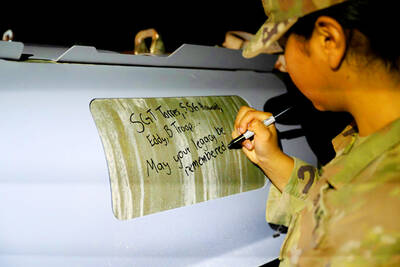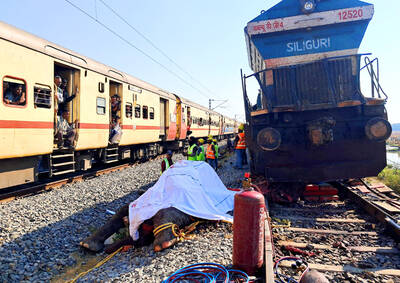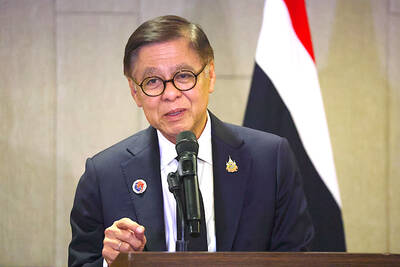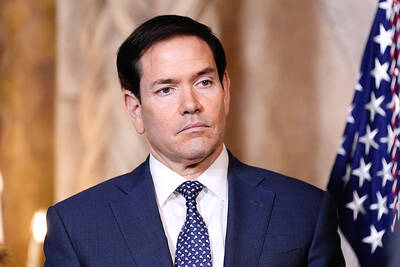The story of how US President George W. Bush ended up with former Iraqi president Saddam Hussein's pistol mounted in his private study off the Oval Office has dribbled out in the last few weeks, and it is a good one.
As first reported in Time magazine, the soldiers who captured Saddam in December presented the mounted sidearm as a gift to Bush in a visit to the White House. They were members of the Army's Delta Force, Bush later said, and they had confiscated the unloaded pistol from Saddam's lap when they pulled him out of his underground bunker near Tikrit.
"It's now the property of the US government," Bush said at a news conference in Savannah, Georgia, when asked specifically about the pistol and whether he would return it to the people of Iraq. What the gun tells us about the president, the war and the relationship of the Bush family to Saddam is another story entirely. It is in many ways better, or at least more interesting, than the first.
`father's shadow'
The Iraqi dictator, after all, tried to assassinate Bush's father in 1993, when he was only a year out of the White House, as payback for the 1991 Persian Gulf war that the former president George Bush had waged on Saddam. In other words, the gun is more than a gun, at least according to the Freudians.
"It's the phallic equivalent of a scalp -- I mean that quite seriously," said Stanley Renshon, a psychoanalyst and political scientist at the City University of New York who has just completed a book, to be published by Palgrave/Macmillan in September, called In His Father's Shadow: The Transformations of George W. Bush.
In Renshon's view, Bush went to war for geostrategic reasons, but there was a powerful personal element as well. In short, Saddam's gun is a trophy that symbolizes victories both military and psychic.
"There are a lot of different levels at which this operates," Renshon said.
"The critics say this is all about finishing up Daddy's mess. I think that is way too off base to be serious. But psychology operates regardless of party line, and this seems to me to be a case in which psychology can't help but express itself, because it's a natural outgrowth of what he's been through and how he feels about it. It's perfectly normal to me," Renshon said.
Michael Sherry, a military historian at Northwestern University, noted that there was a long record of soldiers seizing the weapons of vanquished enemies as the ultimate symbols of defeat. (Even so, it is illegal for American soldiers to take guns from an enemy and keep them for themselves, which is almost certainly why the president declared that the pistol was US government property, rather than his own.)
Relinquishing weapons has historically been part of surrender ceremonies, even though Ulysses Grant chose not to ask for Robert Lee's sword at Appomattox Court House in 1865 and excluded officers' sidearms from the weapons that the Army of Northern Virginia was expected to turn over to him.
`childish'
Saddam's pistol, which Bush shows off to visitors, is a different matter altogether, Sherry said, because it was presidential acquisition by force. "Whatever specific symbolism Bush may privately attach to this token, it does make it look to the external viewer that he sees this in very personal terms," Sherry said. In the end, he said, "I'm left feeling that it sounds kind of childish."
Other presidents, Theodore Roosevelt in particular, have had guns, and many others have kept tokens of what they consider the most historic moments of their presidencies.
The Ronald Reagan Library displays a graffiti-covered section of the Berlin Wall, which Reagan famously called on former Soviet leader Mikhail Gorbachev to tear down; George Washington kept a key to the Bastille sent to him after the French Revolution by the Marquis de Lafayette, who served under Washington in the American Revolution and considered an inspiration for French liberty.
Bush keeps at least one other war-related token: the badge of George Howard, a Port Authority police officer who died at the World Trade Center on Sept. 11, 2001, given to him by Howard's mother. Bush held up the badge in his address to a joint session of Congress nine days after the attacks and declared: "This is my reminder of lives that ended, and a task that does not end."
In that context, Saddam's pistol is a bookend of sorts, the prize of a president who viewed the badge as reason for waging two wars. To the Delta Force that brought it back, the gun is a piece of history representing nothing less than mission complete.

REVENGE: Trump said he had the support of the Syrian government for the strikes, which took place in response to an Islamic State attack on US soldiers last week The US launched large-scale airstrikes on more than 70 targets across Syria, the Pentagon said on Friday, fulfilling US President Donald Trump’s vow to strike back after the killing of two US soldiers. “This is not the beginning of a war — it is a declaration of vengeance,” US Secretary of Defense Pete Hegseth wrote on social media. “Today, we hunted and we killed our enemies. Lots of them. And we will continue.” The US Central Command said that fighter jets, attack helicopters and artillery targeted ISIS infrastructure and weapon sites. “All terrorists who are evil enough to attack Americans are hereby warned

Seven wild Asiatic elephants were killed and a calf was injured when a high-speed passenger train collided with a herd crossing the tracks in India’s northeastern state of Assam early yesterday, local authorities said. The train driver spotted the herd of about 100 elephants and used the emergency brakes, but the train still hit some of the animals, Indian Railways spokesman Kapinjal Kishore Sharma told reporters. Five train coaches and the engine derailed following the impact, but there were no human casualties, Sharma said. Veterinarians carried out autopsies on the dead elephants, which were to be buried later in the day. The accident site

RUSHED: The US pushed for the October deal to be ready for a ceremony with Trump, but sometimes it takes time to create an agreement that can hold, a Thai official said Defense officials from Thailand and Cambodia are to meet tomorrow to discuss the possibility of resuming a ceasefire between the two countries, Thailand’s top diplomat said yesterday, as border fighting entered a third week. A ceasefire agreement in October was rushed to ensure it could be witnessed by US President Donald Trump and lacked sufficient details to ensure the deal to end the armed conflict would hold, Thai Minister of Foreign Affairs Sihasak Phuangketkeow said after an ASEAN foreign ministers’ meeting in Kuala Lumpur. The two countries agreed to hold talks using their General Border Committee, an established bilateral mechanism, with Thailand

‘POLITICAL LOYALTY’: The move breaks with decades of precedent among US administrations, which have tended to leave career ambassadors in their posts US President Donald Trump’s administration has ordered dozens of US ambassadors to step down, people familiar with the matter said, a precedent-breaking recall that would leave embassies abroad without US Senate-confirmed leadership. The envoys, career diplomats who were almost all named to their jobs under former US president Joe Biden, were told over the phone in the past few days they needed to depart in the next few weeks, the people said. They would not be fired, but finding new roles would be a challenge given that many are far along in their careers and opportunities for senior diplomats can